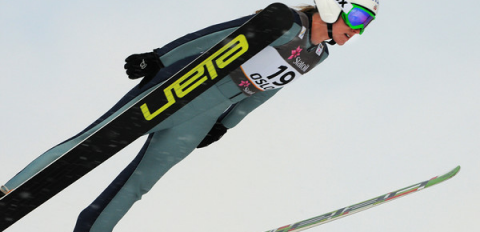
2011 an historic year for ski jumping.
By Seth Masia
Ski Flying Record
On Feb. 11, 2011 Johan Remen Evensen took advantage of the newly-enlarged Vikersund 225-meter ski-flying hill in Norway, to set a new world record of 246.5 meters. That surpassed the previous record of 239m, set by Bjoern Einar Romoeren in March 2005 on the 215-meter hill at Planica, Slovenia.
Evensen, 25, went on to win his first-ever World Cup victory the following day, and finished the season 11th in World Cup points. Regarded by his Norwegian teammates as a late bloomer, Evensen’s previous career includes a bronze medal at the Vancouver Olympics and three silver medals at World Championships in 2009, 2010 and 2011 – all in team jumping events.
For video of Evensen’s record jump, see http://www.youtube.com/watch?v=453UBJjB1jc
College Ski Jumping Returns
On Mar. 5, the United States Collegiate Ski and Snowboard Association revived intercollegiate ski jumping, moribund in the United States since 1980, when the National Collegiate Athletic Association abandoned the sport. Alissa Johnson and Willy Graves, both of Utah’s Westminster College, won the first USCSSA National Championships, held on the K90 hill at the Olympic Training Park in Park City, Utah. Longest jumps of the day belonged to J1-class athletes Eric Mitchell (241.5 points, 90.5m and 102m), a member of Canada’s national ski team, and Sarah Hendrickson (225.5 points, 99m and 89.5m) of the U.S. Ski Team.
The results underscored the new strength of women in the jumping world: Hendrickson’s performance would have beaten Graves (281.5 points, 84.5m and 94m), had they been competing in the same class, and would have put her second in the men’s J1 class.
Twenty-eight athletes from Westminster College, University of Utah, University of Colorado, Carelton College, Utah Valley University and the University of Minnesota launched off the K90 ski jump. Officially, NCAA dropped ski jumping three decades ago due to liability concerns and a purported deficit of elite American jumpers. Insiders, however, say that colleges with weak jumping squads voted to kill jumping to strengthen the chances that points earned in alpine and cross country events would move them up in NCAA championship point standings.
Women to Jump at 2014 Olympics
Finally, on April 6, the International Olympic Committee approved the addition of women’s ski jumping as a medal event for the Sochi Games in 2014. The decision capped a decade of lobbying to bring women’s jumping to World Championship and Olympic venues. FIS upgraded women’s jumping to Continental Cup status for the 2004-05 season, and in 2006 added it to the World Championship schedule (for 2009, when the first gold medal was won by Utah’s Lindsey Van). Women will have their own World Cup circuit beginning in the 2011-12 season.
Nine women currently jump for the U.S. Ski Team, and 87 women from around the world competed in 20 Continental Cup events during the past season. In an era when light weight equates to long jumps, women have consistently jumped within about 3 percent of championship distances by men on the same hills, and have occasionally set hill records.
For now, the Olympic event for women is confined to individual medals on the small hill, but it opens the door for future women’s Olympic competition in team events and Nordic combined. It also remains to be seen if mainstream sports reporters can distinguish between jumping champion Lindsey Van and alpine champion Lindsey Vonn.
Women’s ski jumping has a long history. Writing in the March, 2009 issue of Skiing Heritage, Byron Rempel traced it back to 1862, when Ingrid Olavsdottir Vestby participated in the first recorded ski jump competition, in Trysil, Norway. While a number of women managed to jump in exhibitions and winter carnivals, especially in North America, it wasn’t until 1972 that Norway’s Anita Wold was allowed to jump at Holmenkollen. A breakthrough came in 1991, when Austrians Eva Ganster and Michaela Schmidt began pre-jumping for FIS competitions, thanks in part to pressure brought on FIS by their fathers. In 1994, at 16, Ganster jumped 113.5 meters on the Lillehammer Olympic hill. Thereafter, FIS allowed women to jump in demonstration events. In 1999, the U.S. Ski Association added a women’s class in the U.S. Ski Jumping Championships, and in 2002 FIS launched its Ladies’ Tour Ski Jumping series.
